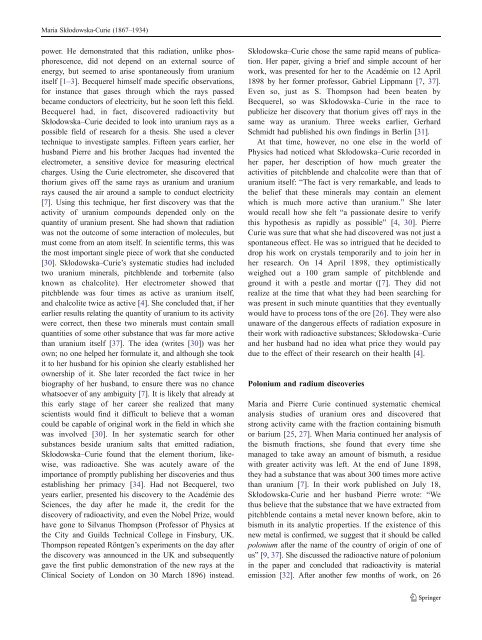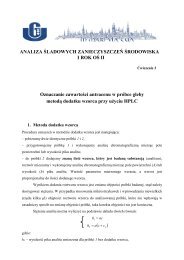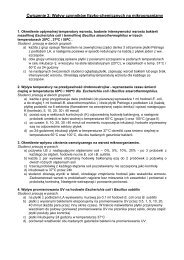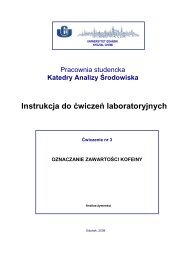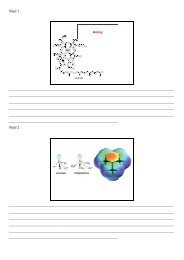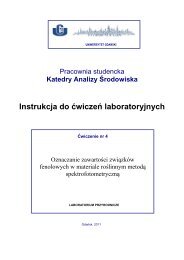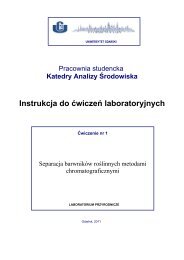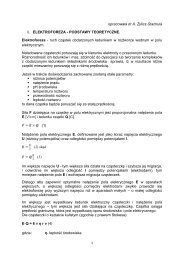Maria Skłodowska-Curie (1867–1934)—her life and discoveries
Maria Skłodowska-Curie (1867–1934)—her life and discoveries
Maria Skłodowska-Curie (1867–1934)—her life and discoveries
Create successful ePaper yourself
Turn your PDF publications into a flip-book with our unique Google optimized e-Paper software.
<strong>Maria</strong> <strong>Skłodowska</strong>-<strong>Curie</strong> (<strong>1867–1934</strong>)power. He demonstrated that this radiation, unlike phosphorescence,did not depend on an external source ofenergy, but seemed to arise spontaneously from uraniumitself [1–3]. Becquerel himself made specific observations,for instance that gases through which the rays passedbecame conductors of electricity, but he soon left this field.Becquerel had, in fact, discovered radioactivity but<strong>Skłodowska</strong>–<strong>Curie</strong> decided to look into uranium rays as apossible field of research for a thesis. She used a clevertechnique to investigate samples. Fifteen years earlier, herhusb<strong>and</strong> Pierre <strong>and</strong> his brother Jacques had invented theelectrometer, a sensitive device for measuring electricalcharges. Using the <strong>Curie</strong> electrometer, she discovered thatthorium gives off the same rays as uranium <strong>and</strong> uraniumrays caused the air around a sample to conduct electricity[7]. Using this technique, her first discovery was that theactivity of uranium compounds depended only on thequantity of uranium present. She had shown that radiationwas not the outcome of some interaction of molecules, butmust come from an atom itself. In scientific terms, this wasthe most important single piece of work that she conducted[30]. <strong>Skłodowska</strong>–<strong>Curie</strong>’s systematic studies had includedtwo uranium minerals, pitchblende <strong>and</strong> torbernite (alsoknown as chalcolite). Her electrometer showed thatpitchblende was four times as active as uranium itself,<strong>and</strong> chalcolite twice as active [4]. She concluded that, if herearlier results relating the quantity of uranium to its activitywere correct, then these two minerals must contain smallquantities of some other substance that was far more activethan uranium itself [37]. The idea (writes [30]) was herown; no one helped her formulate it, <strong>and</strong> although she tookit to her husb<strong>and</strong> for his opinion she clearly established herownership of it. She later recorded the fact twice in herbiography of her husb<strong>and</strong>, to ensure there was no chancewhatsoever of any ambiguity [7]. It is likely that already atthis early stage of her career she realized that manyscientists would find it difficult to believe that a womancould be capable of original work in the field in which shewas involved [30]. In her systematic search for othersubstances beside uranium salts that emitted radiation,<strong>Skłodowska</strong>–<strong>Curie</strong> found that the element thorium, likewise,was radioactive. She was acutely aware of theimportance of promptly publishing her <strong>discoveries</strong> <strong>and</strong> thusestablishing her primacy [34]. Had not Becquerel, twoyears earlier, presented his discovery to the Académie desSciences, the day after he made it, the credit for thediscovery of radioactivity, <strong>and</strong> even the Nobel Prize, wouldhave gone to Silvanus Thompson (Professor of Physics atthe City <strong>and</strong> Guilds Technical College in Finsbury, UK.Thompson repeated Röntgen’s experiments on the day afterthe discovery was announced in the UK <strong>and</strong> subsequentlygave the first public demonstration of the new rays at theClinical Society of London on 30 March 1896) instead.<strong>Skłodowska</strong>–<strong>Curie</strong> chose the same rapid means of publication.Her paper, giving a brief <strong>and</strong> simple account of herwork, was presented for her to the Académie on 12 April1898 by her former professor, Gabriel Lippmann [7, 37].Even so, just as S. Thompson had been beaten byBecquerel, so was <strong>Skłodowska</strong>–<strong>Curie</strong> in the race topublicize her discovery that thorium gives off rays in thesame way as uranium. Three weeks earlier, GerhardSchmidt had published his own findings in Berlin [31].At that time, however, no one else in the world ofPhysics had noticed what <strong>Skłodowska</strong>–<strong>Curie</strong> recorded inher paper, her description of how much greater theactivities of pitchblende <strong>and</strong> chalcolite were than that ofuranium itself: “The fact is very remarkable, <strong>and</strong> leads tothe belief that these minerals may contain an elementwhich is much more active than uranium.” She laterwould recall how she felt “a passionate desire to verifythis hypothesis as rapidly as possible” [4, 30]. Pierre<strong>Curie</strong> was sure that what she had discovered was not just aspontaneous effect. He was so intrigued that he decided todrop his work on crystals temporarily <strong>and</strong> to join her inher research. On 14 April 1898, they optimisticallyweighed out a 100 gram sample of pitchblende <strong>and</strong>ground it with a pestle <strong>and</strong> mortar ([7]. They did notrealize at the time that what they had been searching forwas present in such minute quantities that they eventuallywould have to process tons of the ore [26]. They were alsounaware of the dangerous effects of radiation exposure intheir work with radioactive substances; <strong>Skłodowska</strong>–<strong>Curie</strong><strong>and</strong> her husb<strong>and</strong> had no idea what price they would paydue to the effect of their research on their health [4].Polonium <strong>and</strong> radium <strong>discoveries</strong><strong>Maria</strong> <strong>and</strong> Pierre <strong>Curie</strong> continued systematic chemicalanalysis studies of uranium ores <strong>and</strong> discovered thatstrong activity came with the fraction containing bismuthor barium [25, 27]. When <strong>Maria</strong> continued her analysis ofthe bismuth fractions, she found that every time shemanaged to take away an amount of bismuth, a residuewith greater activity was left. At the end of June 1898,they had a substance that was about 300 times more activethan uranium [7]. In their work published on July 18,<strong>Skłodowska</strong>-<strong>Curie</strong> <strong>and</strong> her husb<strong>and</strong> Pierre wrote: “Wethus believe that the substance that we have extracted frompitchblende contains a metal never known before, akin tobismuth in its analytic properties. If the existence of thisnew metal is confirmed, we suggest that it should be calledpolonium after the name of the country of origin of one ofus” [9, 37]. She discussed the radioactive nature of poloniumin the paper <strong>and</strong> concluded that radioactivity is materialemission [32]. After another few months of work, on 26


